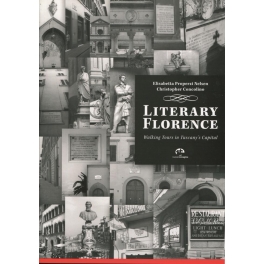Literary Florence
 Ingrandisci
Ingrandisci Walking Tours in Tuscany’s Capital
- Autore: Elisabetta Properzi Nelsen and Christopher Concolino
- Anno: 2006
- Formato: 17 x 24 cm.
- Pagine: 160 pp., ill
- ISBN: 88-7145-240-2
 Ingrandisci
Ingrandisci Walking Tours in Tuscany’s Capital
Just as Foscolo in the first years of the nineteenth century was moved to recall Florence’s mythological and literary past in Le Grazie (above), many others before and after him were also inspired to write in this city, Tuscany’s capital. Most, if not all, of the places where these writers lived have hardly changed, and so it’s possible to uncover traces of their lives in Florence’s palaces, streets and city squares. This book identifies these places and arranges them in eleven itineraries. The sites offer a feast for the eyes that is singularly and justifiably famous – but immeasurably enhanced by the appreciation of each location’s historical and literary importance.
Florence did not give birth to Italy’s first school of poetry nor to the oldest documented traces of Italian dialects. Many talented thirteenth-century Sicilians and Umbrians left works of lasting importance dealing with love and religious themes, but Italy’s second poetic school, the Dolce Stil Novo (Sweet New Style) flowered in Florence, and marked its history forever after.
Since the mid-thirteenth century Florence has been considered the cradle of Italian language and literature due to the success of works from this period by Dante Alighieri, Francesco Petrarca and Giovanni Boccaccio. Love intertwined with religious and moral themes were at the center of their poetry and prose. Known as the “three crowns,” these men provided the first literary examples of highly developed poetry and prose in a single regional dialect: Florentine Tuscan. Perhaps better described as a “volgare illustre” (a literary vulgar tongue), Florentine became the model for anyone putting pen to paper on the Italian peninsula. This fact was officially recognized centuries later during the Renaissance, when the poet and literary theorist Pietro Bembo acknowledged Tuscan’s sovereignty over other dialects when he wrote in his Prose della volgar lingua (The Style of Written Italian) that “Tuscan is harmonious when spoken and correct when written.” But Florence has attained the status of a literary homeland for other reasons.
For Dante in exile, it represented the city loved, hated and lost forever – yet retrieved allegorically both in Heaven and in Hell. Florence therefore becomes at once the locus of historical and personal memory par excellence as well as the center of his poetic imagination. This same metaphorical connotation has also appealed to non-Florentines. For a writer of tragedies from Piedmont such as Vittorio Alfieri or for the Milanese novelist Alessandro Manzoni, Florence was the place to absorb Italy’s literary tongue in person and “rinse [one’s] clothes in the Arno,” to use Manzoni’s words. For the romantic Ugo Foscolo, it was the custodian of Italy’s poetic and artistic greatness, which he identified particularly with the tombs in the church of Santa Croce, a virtual pantheon of creative personalities. One of his contemporaries, Elizabeth Barrett Browning, found her second homeland in Florence and fervently supported the Risorgimento, Italy’s nineteenth-century movement in favor of unification and liberation from under the yoke of Hapsburg and Bourbon domination. In stark contrast to this, Dante’s home town was a city of exile for Dostoevsky, who completed The Idiot across the street from the Pitti Palace. Other foreigners such as E.M. Forster and D.H. Lawrence saw the city’s refined Renaissance beauty balanced by the spontaneity and naturalness of its inhabitants, while John Ruskin interpreted Florence as a “jewel box” in which he could rediscover Gothic art in the nineteenth century.
These literary walks aim to retrieve an urban past that offers the reader places rich in history, curiosities and poetic memory. Nonetheless, Florence has changed over the centuries and must now deal with contemporary problems facing any city – even though it still proffers a Medieval and Renaissance environment and, as such, the quintessential tourist destination.
Automobile and motorbike traffic unfortunately contribute to a certain level of noise pollution, but the itineraries included herein help the reader’s imagination return to a silent dimension in the literary past. In walking through Florence’s streets, all visitors – be they tourists, scholars or the merely curious – will enjoy reading aloud the engraved words on the plaques marking each literary site, which still function as a source of inspiration for writers today.